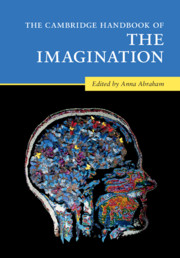Book contents
- The Cambridge Handbook of the Imagination
- The Cambridge Handbook of the Imagination
- Copyright page
- Dedication
- Contents
- Figures
- Contributors
- Acknowledgments
- 1 Surveying the Imagination Landscape
- Part I Theoretical Perspectives on the Imagination
- Part II Imagery-Based Forms of the Imagination
- Part III Intentionality-Based Forms of the Imagination
- Part IV Novel Combinatorial Forms of the Imagination
- Part V Phenomenology-Based Forms of the Imagination
- Part VI Altered States of the Imagination
- 40 Dreaming: Beyond Imagination and Perception
- 41 Dreaming is Imagination Roaming Freely, Based On Embodied Simulation, and Subserved by an Unconstrained Default Network
- 42 Aphantasia
- 43 Hypnosis and Imagination
- 44 Hallucinations and Imagination
- 45 The Psychiatry of Imagination
- 46 Meditation and Imagination
- 47 Flow in Performance and Creative Cognition – An Optimal State of Task-Based Adaptation
- 48 The Force of the Imagination
- Name Index
- Subject Index
- References
42 - Aphantasia
from Part VI - Altered States of the Imagination
Published online by Cambridge University Press: 26 May 2020
- The Cambridge Handbook of the Imagination
- The Cambridge Handbook of the Imagination
- Copyright page
- Dedication
- Contents
- Figures
- Contributors
- Acknowledgments
- 1 Surveying the Imagination Landscape
- Part I Theoretical Perspectives on the Imagination
- Part II Imagery-Based Forms of the Imagination
- Part III Intentionality-Based Forms of the Imagination
- Part IV Novel Combinatorial Forms of the Imagination
- Part V Phenomenology-Based Forms of the Imagination
- Part VI Altered States of the Imagination
- 40 Dreaming: Beyond Imagination and Perception
- 41 Dreaming is Imagination Roaming Freely, Based On Embodied Simulation, and Subserved by an Unconstrained Default Network
- 42 Aphantasia
- 43 Hypnosis and Imagination
- 44 Hallucinations and Imagination
- 45 The Psychiatry of Imagination
- 46 Meditation and Imagination
- 47 Flow in Performance and Creative Cognition – An Optimal State of Task-Based Adaptation
- 48 The Force of the Imagination
- Name Index
- Subject Index
- References
Summary
Writing in the 1880s, Galton recognized that some healthy individuals lack visual imagery. This phenomenon has been relatively neglected since then. In 2015 we coined the term “aphantasia” to describe the lack of the mind’s eye, reporting on twenty-one individuals with a lifelong lack of imagery. Since then we have been contacted by many thousands of people lying at both the aphantasic and the hyperphantasic extremes of the vividness spectrum. Preliminary evidence suggests that lifelong aphantasia is associated variably with prosopagnosia and reduction in autobiographical memory; hyperphantasia is associated with synaesthesia. Over 50 percent of people with aphantasia report visual dreaming. In around 50 percent of our aphantasic participants, all modalities of imagery are affected, while in others some modalities of imagery are preserved. Aphantasia often runs in families. Functional imaging studies of imagery suggest a range of hypotheses for the neural correlates of aphantasia; the few functional imaging studies specifically examining imagery vividness point to positive correlations with brain activity in higher visual and memory-related areas. The study of aphantasia reminds us how easily invisible differences can escape detection. Visualization is only one of many ways of representing things in their absence, and individuals lacking visual imagery can be highly imaginative.
Keywords
- Type
- Chapter
- Information
- The Cambridge Handbook of the Imagination , pp. 692 - 710Publisher: Cambridge University PressPrint publication year: 2020
References
- 5
- Cited by

